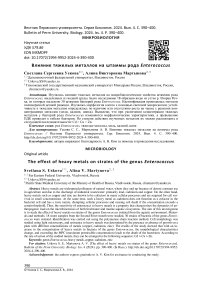Влияние тяжелых металлов на штаммы рода Enterococcus
Автор: Ускова С.С., Мартынова А.В.
Журнал: Вестник Пермского университета. Серия: Биология @vestnik-psu-bio
Рубрика: Микробиология
Статья в выпуске: 4, 2024 года.
Бесплатный доступ
Изучалось влияние тяжелых металлов на микробиологические свойства штаммов рода Enterococcus, выделенных из водной среды. Было исследовано 18 образцов воды из устья р. Вторая Речка, из которых выделено 30 штаммов бактерий рода Enterococcus. Идентификация проводилась методом полимеразной цепной реакции. Изучалась морфология клеток с помощью световой микроскопии; устойчивость к тяжелым металлам определялась по наличию или отсутствию роста на чашке с разными концентрациями металлов (меди, кадмия, цинка). Выявлено, что при увеличении концентрации тяжелых металлов у бактерий рода Enterococcus изменяются морфологические характеристики, а превышение ПДК приводит к гибели бактерии. По степени действия изученных металлов их можно расположить в следующей последовательности: Cd > Cu > Zn.
Род enterococcus, тяжелые металлы, медь, кадмий, цинк
Короткий адрес: https://sciup.org/147247244
IDR: 147247244 | УДК: 579.86 | DOI: 10.17072/1994-9952-2024-4-390-400
Текст научной статьи Влияние тяжелых металлов на штаммы рода Enterococcus
Тяжелые металлы являются естественными компонентами морской и пресноводной среды и обычно встречаются в очень низких концентрациях [Shah, 2021]. Природные процессы, способствующие распространению этих металлов в окружающей среде, включают эрозию, извержения вулканов и выветривание полезных ископаемых, при этом они обычно находятся в нерастворимых формах [Ayangbenro, Babalola, 2017].
Антропогенная деятельность, такая как дренаж шахт, морская разведка нефти и газа, промышленные (пестициды, краски, кожа, текстиль, удобрения, фармацевтические препараты) и бытовые сточные воды, сельскохозяйственные стоки, сбросы кислотных дождей, а также прибрежное строительство и дноуглубительные работы, неизбежно увеличили концентрации металлов в морской среде [Fu, Wang, 2011]. Тяжелые металлы из антропогенных источников обычно имеют высокую биодоступность благодаря своим растворимым и подвижным реакционноспособным формам [Ayangbenro, Babalola, 2017].
Энтерококки – это представители нормальной микрофлоры кишечника человека и животных, но также они могут выделяться из носоглотки, верхних дыхательных путей, мочеполовой системы и кожных покровов [Barbosa, Borges, Teixeira, 2014]. Ранее считалось, что микроорганизмы рода Enterococcus являются эпидемиологически малозначимыми, т.к. достаточно редко регистрировались микробиологически подтвержденные клинические случаи энтерококковых инфекций. Однако данная точка зрения была пересмотрена, поскольку у бактерий данной группы были обнаружены факторы вирулентности и оценена их активность [Красная, Нестеров, Потатуркина-Нестерова, 2014]. Патогенность представителей рода Enterococcus обусловлена их чувствительностью к антибиотикам и наличием детерминант патогенности в генетической информации. Наиболее распространенными видами в этой группе являются E. faecalis и E. faecium , причем E. faecalis встречается чаще. Соотношение этих микроорганизмов в водной среде зависит от экологических условий. В микробиоценозе могут присутствовать и другие виды рода Enterococcus . E. faecalis – более патогенен, чем E. faecium , однако последний обладает большей устойчивостью к антибиотикам [Butaye, Devriese, Haesebrouck, 2001]. Такие представители энтерококков, как Enterococcus durans , Enterococcus avium , Enterococcus gallinarum и Enterococcus casseliflavus, проявляют патогенные свойства лишь в единичных случаях [Sadowy, Luczkiewicz, 2014].
Несмотря на то, что энтерококки могут выживать как в пресной, так и в морской воде, до сих пор нет единого мнения относительно их способности расти и размножаться в этих средах из-за нехватки питательных веществ [Cesare et al., 2014]. Несмотря на это, энтерококки могут быть выделены из множества условий окружающей среды с различной доступностью питательных веществ, таких как почва, пресная вода, пляжи и очистные сооружения [Красная, Нестеров, Потатуркина-Нестерова, 2014]. Сточные воды, не прошедшие должную очистку, могут стать источником загрязнения как поверхностных, так и подземных вод, что представляет собой серьезную угрозу для окружающей среды. Это может произойти вследствие неэффективности систем очистки сточных вод, а также из-за неполадок или перегруженности систем водоотведения. Кроме того, сточные воды могут содержать отходы животноводства, которые, попадая на сушу или в водоемы, создают угрозу для людей, которые могут случайно употребить загрязненную воду или вступить с ней в контакт в повседневной жизни [Burgmann et. al., 2018].
В более новых исследованиях, в особенности с применением молекулярно-генетических методов, была подтверждена способность микроорганизмов рода Enterococcus приобретать устойчивость к антибактериальным химиопрепаратам, а также к высушиванию, температуре и действию других физических, химических и биологических факторов [Gin, Goh, 2013]. Данная особенность позволяет им выживать в желудочно-кишечном тракте и колонизировать толстый кишечник, также их выделяют с кожи, ротовой полости и женского мочеполового тракта [Barbosa, Borges, Teixeira, 2014]. Попадая в окружающую среду, они могут некоторое время сохраняться в жизнеспособном, но некультивируемом состоянии [Gin, Goh, 2013], а в некоторых местах, например таких, как морская вода, они могут обмениваться генами устойчивости к антибиотикам и металлам с другими бактериями [Cesare et al, 2014].
Тяжелые металлы, такие как медь и цинк, являются кофакторами многих клеточных процессов и необходимы для выживания клеток, но они нужны в небольших концентрациях [Arguello, Raimunda, Padilla-Benavides, 2013]. Однако такой тяжелый металл, как кадмий, не выполняет функции кофактора в бактериальной клетке и по своей природе токсичен, нарушая клеточные процессы и вызывая гибель клеток, если концентрация выше определенного порога [Arguello, Raimunda, Padilla-Benavides, 2013; Parsons, Lee, Kathariou, 2020].
Медь является важным микроэлементом в клетках и выполняет несколько биологических функций. Она служит значимым структурным компонентом и каталитическим кофактором для широкого спектра различных ферментов в важных биохимических путях у бактерий, растений и животных [Zhang et al., 2015]. Сульфат меди используется в кормах для свиней и кур в качестве стимулятора роста. [Garrido, Galvez, Pulido, 2014]. Ген tcrB , расположенный в плазмиде, отвечает за устойчивость к меди. Ген trcB (обнаруженный в опероне tcrYAZB, гомологичный оперону copYAZAB, определяющий гомеостаз меди)
кодирует предполагаемый белок, принадлежащий к семейству АТФаз CPx-типа переносчиков тяжелых металлов. Бактерии, несущие плазмидный оперон tcrYAZB, могут переносить до 28 мМ сульфата меди, в то время как те, у которых отсутствует этот ген, могут переносить только до 8 мМ [Hasman, Aarestrup, 2002]. Ген tcrB генетически связан с генами, кодирующими устойчивость к макролидам ( erm B ) и гликопептидам ( vanA ) в плазмидах, из энтерококков, выделенных от свиней [Garrido, Galvez, Pulido, 2014].
Цинк является компонентом многих белков, таких как ДНК-полимеразы, протеазы и рибосомальные белки, а также кофактором многих ферментативных реакций. Несмотря на важность цинка, его избыток может быть вредным, поскольку он может конкурировать с другими металлами за связывание с активными центрами ферментов [Somerville, Proctor, 2009]. Два гена E. faecalis , кодирующие АТФазу P-типа, EF1400 и белок SapB EF0759, значимо активируются в присутствии высоких концентраций цинка. Zn2+-чувствительный ДНК-связывающий мотив присутствует в промоторных областях этих генов [Abrantes, Kok, Lopes, 2014].
Кадмий. В настоящее время считается, что кадмий не является кофактором биохимических процессов в клетке и по своей природе токсичен, нарушая клеточные процессы и вызывая гибель клеток выше определенного порога. Хотя этот металл может естественным образом присутствовать в окружающей среде или в результате антропогенного загрязнения, его распределение в окружающей среде имеет тенденцию быть неоднородным, и обычно он встречается в больших количествах только в определенных экосистемах [Parsons, Lee, Kathariou, 2020]. Кадмий оказывает чрезвычайно токсичное действие на микроорганизмы при относительно низких дозах [Abou-Shanab , Berkum, Angle, 2007]. Кадмий может связываться с сульфгидрильными группами и, как следствие, – нарушать функцию белка [Jungmann et al., 1993] . Кроме того, кадмий является репрессором тиоредоксина, который обеспечивает восстанавливающую способность для многих биологических реакций [Li, Krumholz, 2007]. Помимо этого, кадмий влияет на пролиферацию, дифференцировку, апоптоз клеток и увеличивает активацию онкогенов для канцерогенеза [Schwartz, Reis, 2000]. Несмотря на все вышеперечисленное, штаммы E. faecalis проявляют высокую естественную устойчивость к кадмию [Paplace, Boutibonnes, Auffray, 1996]. В процессе защиты E. faecalis от кадмия участвуют такие гены, как cadA, ppx и dsbAм . Механизм абсорбции и устойчивости к кадмию начинается с системы поглощения магния, цинка и кальция [Wu et al., 2014]. Затем кадмий частично транспортируется через АТФазы P-типа [Tsai, Yoon, Lynn, 1992], осажденный фосфатными группами, которые секретировались PpX в виде фосфида кадмия. Затем белок DsbA связывается со свободным ионом кадмия в цитозоле для защиты тиоредоксина и других белков [Wu et al., 2014].
Несмотря на то, что тяжелые металлы могут естественным образом присутствовать в окружающей среде в результате антропогенного загрязнения, их распределение в окружающей среде бывает неоднородным, и они обычно встречаются в больших количествах только в определенных экосистемах. Тем не менее, детерминанты устойчивости к токсичным металлам широко распространены у грамположительных бактерий и содержатся либо в хромосомах, либо на мобильных генетических элементах, таких как транспозоны и плазмиды, включая интегративные и конъюгативные элементы. Эти детерминанты могут распространяться посредством горизонтального переноса генов и, таким образом, могут быть широко распространены и высококонсервативны [Parsons, Lee, Kathariou, 2020]. Деятельность человека, способствующая такому распространению, и является однозначным фактором, модифицирующим микробиоценоз морских и пресноводных экосистем, что требует включать мониторинг за чувствительностью энтерококков к тяжелым металлам в рутинные схемы микробиологического мониторинга хотя бы на периодической основе. Цель работы – изучить влияние тяжелых металлов , выделенных из водной среды, на микробиологические свойства штаммов рода Enterococcus .
Материалы и методы исследований
Для исследования чувствительности штаммов рода Enterococcus к тяжелым металлам изучено 18 образцов воды из устья р. Вторая Речка (43.160456, 131.905963), т.к. река находится в черте города и подвержена загрязнению тяжелыми металлами [Шулькин, Богданова, Киселев, 2007]. Выделено 30 штаммов бактерий рода Enterococcus, идентификация проводилась методом полимеразной цепной реакции. Штаммы идентифицировали с помощью ПЦР с использованием известных праймеров гена 16S рРНК5’-AACGCGAAGAACCTTAC-3’ 5’-CGGTGTGTACAAGACCC-3’. Размер 440 п.о. [Skowron et al., 2016]. Синтез праймеров осуществлен компанией «Синтол» (Москва, Россия).
Морфологию бактериальных клеток оценивали методом окраски по Граму. Исследование производилось с помощью микроскопа марки Primo Start, производитель Zeiss. Отмечали окраску мазка, а также размер, форму, способ расположения бактерий на предметном стекле [Прунтова, 2005].
Изучение устойчивости к металлам. Устойчивость к металлам изучали на среде для морских микроорганизмов (СММ) (г/л: CaCO 3 – 1.0; MgSO 4 – 1.0; пептон – 5.0; дрожжевой экстракт – 5.0; K 2 HPO 4 –
0.2; глюкоза – 0.2; агар – 15.0; дистиллированная вода – 1 000; рН 7.8–8.1) с добавлением в качестве селективной добавки соли металлов (CuSO 4 , ZnSO 4 , CdSO 4 ) в возрастающих концентрациях. Автоклавировали при 121°С в течение 15 мин. Суточную культуру бактерий с помощью микробиологической петли засевали на чашки Петри с питательной средой СММ. Посев проводился в трех повторениях. Культуру выращивали при комнатной температуре в течение 2–3 суток. Учет результатов проводился по наличию или отсутствию роста на чашках с металлами [Бузолева, 2011].
Статистическая обработка данных производилась в программе STATISTICA 10. Графики и таблицы формировались в программе Excel.
Результаты и их обсуждение
При исследовании чувствительности бактерий рода Enterococcus, выделенных в р. Вторая Речка, выявлено, что все выделеные штаммы резистентны к тяжелым металлам (CuSO 4 , ZnSO 4 и CdSO 4 ). Они росли при концентрациях, которые превышали предельно допустимые концентрации (ПДК) [Шулькин, Богданова, Киселев, 2007].
ПДК для меди в морской воде составляет 0.05 мг/л, а в пресной – 0.01 мг/г [Коршенко, 2020], однако 17% (5) штаммов рода Enterococcus, выделенные в бухте р. Вторая Речка, росли при 1 500 мг/л. (рис. 1). При концентрации 1 450 мг/л происходит резкое снижение роста у 57% (17) штаммов рода Enterococcus , поэтому данные штаммы можно считать чувствительными, а 43% (13) продолжают расти, оставаясь при этом устойчивыми.
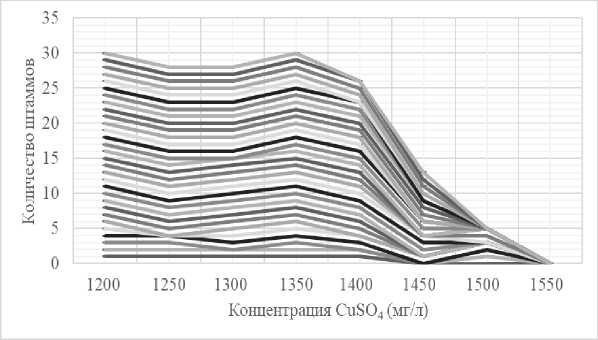
Рис. 1. Влияние различных концентраций меди на культивирование бактерии рода Enterococcus [The effect of different copper concentrations on the cultivation of bacteria of the genus Enterococcus ]
Отмечено изменение культуральных свойств: с увеличением концентрации CuSO 4 до 1 400 мг/л стали появляться непрозрачные колонии оранжевого цвета и с металлическим блеском, а другие колонии, наоборот, стали прозрачными. Также отмечено изменение морфологии бактерий рода Enterococcus: при концентрации 800 мг/л бактериальные клетки располагались парами; при концентрации 1 400 мг/л – бактериальные клетки располагались парами и наблюдалось незначительное увеличение размера клеток; при 1 500 мг/л клетки располагались парами и короткими цепочками и стали более круглыми по сравнению с более низкими концентрациями (рис. 2). Медь может оказывать токсическое воздействие на бактериальные клетки, что связано с ее влиянием на стабильность белков. Медь может как увеличивать, так и уменьшать стабильность белков, особенно тех, которые участвуют в работе рибосом, синтезе белка и регулировании окислительно-восстановительных процессов в клетке [Wiebelhaus et al., 2021].
ПДК для цинка в морской среде составляет 0.05 мг/л, а для пресных вод – 0.01 мг/л [Коршенко, 2020]. Однако изученные штаммы росли и при более высоких концентрациях (рис. 3), демонстрируя при этом различия в морфологии культуры. Также нами было выявлено, что 60% штаммов (18) росли при концентрации 2 150 мг/л и были определены нами как устойчивые, а 40% (12) прекращали рост и являлись чувствительными. При концентрации цинка, равной 800 мг/л, бактериальные клетки располагались парами; при концентрации 1 800 мг/л бактериальные клетки располагались парами, короткими и длинными цепочками и наблюдались плеоморфные клетки (мелкие кокки и крупные палочки); при концентрации 2 100 мг/л бактериальные клетки располагались парами, короткими и длинными цепочками (рис. 4).
Согласно литературным источникам, цинк, подобно меди, способен оказывать токсическое воздействие на бактерии. Это объясняется его влиянием на стабильность белков, которые играют ключевую роль в жизнедеятельности бактериальных клеток. Цинк может влиять на работу рибосом, которые отвечают за синтез белка в бактериальной клетке. Это может привести к нарушению синтеза необходимых белков и, как следствие, к снижению жизнеспособности энтерококков. Цинк играет важную роль в регу- ляции окислительно-восстановительных процессов в бактериальной клетке. Нарушение этих процессов может привести к снижению жизнеспособности энтерококков. Цинк может как увеличивать, так и уменьшать стабильность белков в бактериальной клетке. Это может привести к нарушению работы белков, которые необходимы для жизнедеятельности энтерококков [Frei et al., 2023].
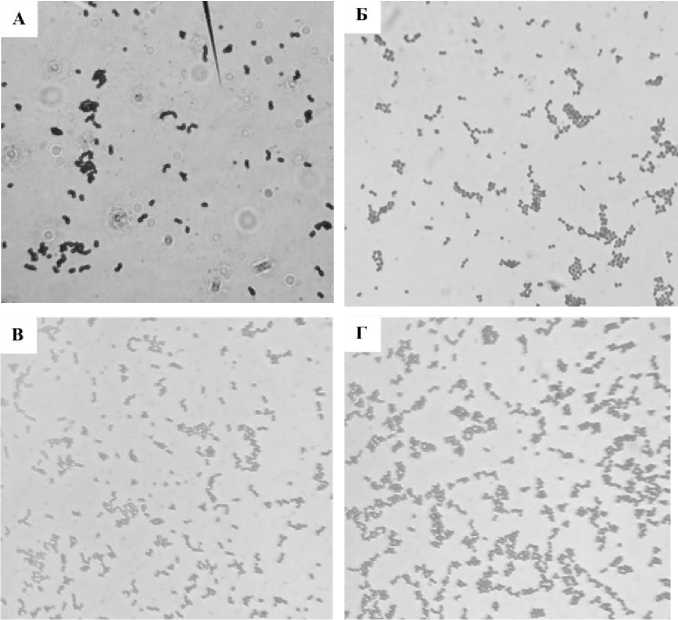
Рис. 2. Влияние различных концентраций меди на морфологию бактерий рода Enterococcus (микроскоп Primo Start, 100×).
Концентрация CuSO 4 : а – контроль (среда СММ без добавления солей металлов), б – 800 мг/л, в – 1 400 мг/л, г – 1 500 мг/л
[Effect of different copper concentrations on the morphology of bacteria of the genus Enterococcus (Primo Start microscope, 100×).
CuSO 4 concentration: a – control (SMM medium without the addition of metal salts), b – 800 mg/l, c – 1400 mg/l, d – 1500 mg/l)]

Концентр ация ZnSO4 (мг/л)
Рис. 3. Влияние различных концентраций цинка на культивирование бактерии рода Enterococcus [The effect of different zinc concentrations on the cultivation of bacteria of the genus Enterococcus ]
ПДК для кадмия в морской воде составляет 0.01 мг/л, а для пресных вод – 0.005 мг/л [Коршенко, 2020]. Однако изученные штаммы росли и при более высоких концентрациях (рис. 5): выявлено, что 37% (11) штаммов растут при концентрации 750 мг/л, следовательно, данные штаммы можно считать устойчивыми, а 63% (19) – чувствительными. При концентрации кадмия 250 мг/л наблюдалось расположение клеток короткими цепочками; при концентрации 500 мг/л наблюдались короткие цепочки и небольшое количество плеоморфных клеток (разных форм и размеров); при концентрации 750 мг/л – наблюдались короткие цепочки и плеоморфные клетки (разных форм и размеров) (рис. 6).
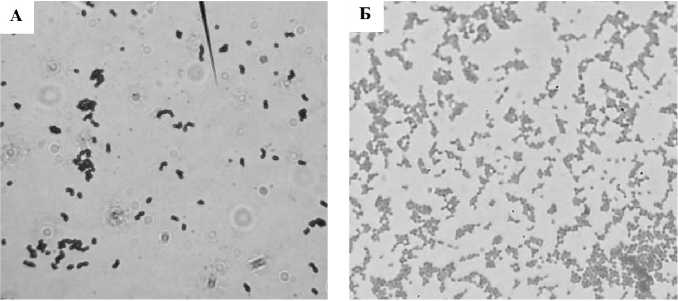
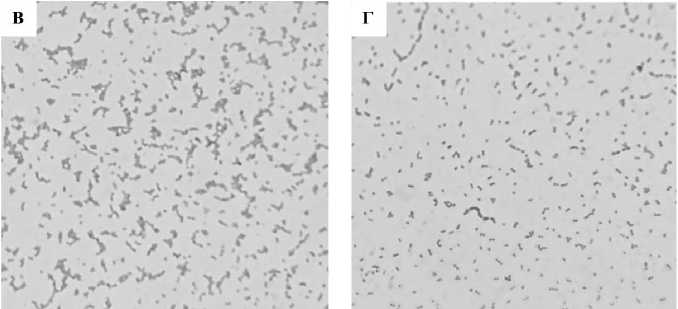
Рис. 4. Влияние различных концентраций цинка на морфологию бактерий рода Enterococcus (микроскоп Primo Start, 100×).
Концентрация ZnSO 4 : а – контроль (среда СММ без добавления солей металлов), б – 800 мг/л, в – 1 800 мг/л, г – 2 200 мг/л
[Effect of different concentrations of zinc on the morphology of bacteria of the genus Enterococcus (Primo Start microscope, 100×).
Concentration of ZnSO 4 : a – control (SMM medium without the addition of metal salts), b – 800 mg/l, c – 1800 mg/l, d – 2200 mg/l]]

Рис. 5. Влияние различных концентраций кадмия на культивирование бактерии рода Enterococcus
[The effect of different cadmium concentrations on the cultivation of bacteria of the genus Enterococcus ]
В соответствии с данными, представленными в научной литературе, кадмий, как и другие тяжелые металлы, может оказывать токсическое воздействие на клетки бактерии. Это связано с его способностью накапливаться в клетках и нарушать их метаболические процессы. Проникая в клетки энтерококков, кадмий способен нарушать целостность их мембран, что приводит к гибели бактерий. Этот процесс обусловлен тем, что кадмий оказывает влияние на работу рибосом, отвечающих за синтез белка в бактериальной клетке. В результате может произойти нарушение синтеза необходимых белков, что негативно сказывается на жизнеспособности энтерококков. Кроме того, кадмий может нарушать работу ферментов, участвующих в окислительно-восстановительных процессах в бактериальной клетке. Накопление кадмия в клетках энтерококков приводит к нарушению метаболических процессов, что негативно сказывается на жизнеспособности бактерий [Li, Krumholz, 2007; Wu et al., 2014]. Однако стоит отметить, что конкретные механизмы воздействия меди, цинка и кадмия на энтерококки требуют дальнейшего изучения. Также необходимо учитывать, что устойчивость энтерококков к цинку может зависеть от многих факторов, таких как концентрация цинка, время воздействия и другие условия эксперимента.
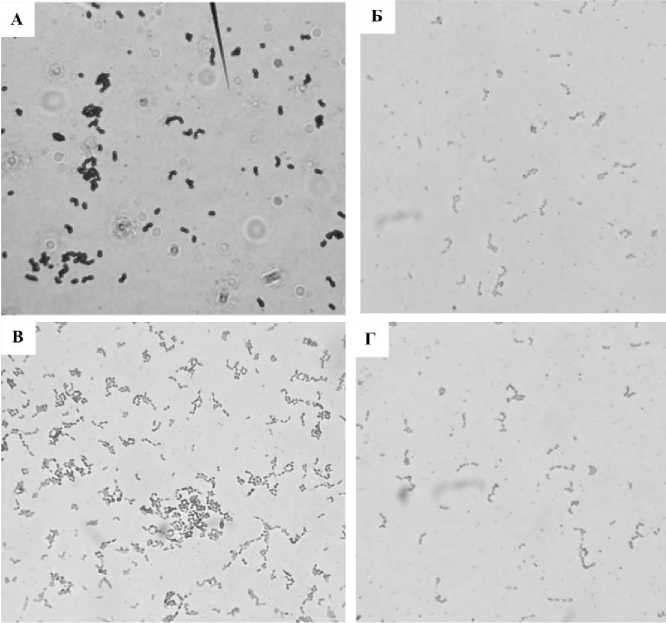
Рис. 6. Влияние различных концентраций кадмия на морфологию бактерий рода Enterococcus (микроскоп Primo Start, 100×).
Концентрация CdSO 4 : а – контроль (среда СММ без добавления солей металлов), б – 250 мг/л, в – 500 мг/л, г – 750 мг/л
[Effect of different cadmium concentrations on the morphology of bacteria of the genus Enterococcus (Primo Start microscope, 100×).
Concentration of CdSO 4 : a – control (SMM medium without the addition of metal salts), b – 250 mg/l, c – 500 mg/l, d – 750 mg]
Проблема устойчивости патогенных микроорганизмов к антибиотикам приобретает глобальный характер. С одной стороны, бактерии становятся все более устойчивыми к существующим препаратам, а с другой – разработка новых антибиотиков замедляется. В связи с этим возникает необходимость поиска альтернативных методов борьбы с инфекциями. Тяжелые металлы, такие как медь, цинк, железо и марганец, играют важную роль в клеточных процессах бактерий. Около 30–40% известных белков содержат металлический кофактор, который критически важен для их структуры или функции [Frei et al., 2023]. Однако эти же металлы становятся токсичными в высоких концентрациях, и бактерии стараются ограничить их поглощение. Тяжелые металлы, будучи токсичными, могут влиять на рост, морфологию и биохимическую активность бактерий, что может привести к изменениям биомассы, а также разнообразия и структуры сообщества [Zhao et al., 2019]. Таким образом, для защиты микробной клетки бактерии регулируют концентрацию тяжелых металлов, используя различные защитные механизмы, ферментативное преобразование в менее токсичные формы, снижение поглощения тяжелых металлов, или другие варианты, которые позволяют бактериям сопротивляться или переносить стресс, вызванный тяжелыми металлами [Gupta et al., 2023].
Заключение
Выяснено, что штаммы бактерий рода Enterococcus способны расти при концентрациях, в тысячи раз превышающие ПДК тяжелых металлов в морской и пресной воде. При увеличении концентрации тяжелых металлов у бактерий рода Enterococcus изменяются морфологические характеристики, а превышение минимальной ингибирующей концентрации приводит к гибели бактерии. По степени действия изученных металлов их можно расположить в следующей последовательности: Cd> Cu> Zn, 800 мг/л, 1 550 мг/л и 2 200 мг/л соответственно. Особенно это важно в связи тем, что устойчивость к тяжелым металлам является селективным фактором для штаммов энтерококков и способствует появлению генетических линий микроорганизмов, выделенных из водных объектов окружающей среды, обладающих измененными свойствами, такими как устойчивость к антимикробным химиопрепаратам.
Список литературы Влияние тяжелых металлов на штаммы рода Enterococcus
- Бузолева Л.С. Микробиологическая оценка качества природных вод. Владивосток, 2011. 85 с.
- Коршенко А.Н. Качество морских вод по гидрохимическим показателям. Ежегодник 2019. М.: Наука, 2020. 281 с.
- Красная Ю.В., Нестеров А.С., Потатуркина-Нестерова Н.И. Значение бактерий рода Enterococcus в жизнедеятельности человека // Современные проблемы науки и образования. 2014. № 3. С. 1169-1178.
- Прунтова О.В. Лабораторный практикум по общей микробиологии. М.: Владимир, 2005. 77 с.
- Шулькин В.М., Богданова Н.Н., Киселев В.И. Металлы в речных водах Приморского края // Геохимия. 2007. Т. 1. С. 79-88.
- Abou-Shanab R., Berkum V.P., Angle J. Heavy metal resistance and genotypic analysis of metal resistance genes in gram-positive and gram-negative bacteria present in Ni-rich serpentine soil and in the rhizosphere of Alyssum murale // Chemosphere. 2007. Vol. 68. P. 360-367. DOI: 10.1016/j.chemosphere.2006.12.051.
- Abrantes M.C., Kok J., Lopes M.de F.S. Enterococcus faecalis zinc-responsive proteins mediate bacterial defence against zinc overload, lysozyme and oxidative stress // Microbiology. 2014. Vol. 160. P. 2755-2762. DOI: 10.1099/mic.0.080341-0.
- Arguello J.M., Raimunda D., Padilla-Benavides T. Mechanisms of copper homeostasis in bacteria // Frontiers in Cellular and Infection Microbiology. 2013. Vol. 3, № 73. P. 1-14. DOI: 10.3389/fcimb.2013.00073.
- Ayangbenro A.S., Babalola O.O. A new strategy for heavy metal polluted environments: a review of microbial biosorbents // Int. J. Environ. Res. Public. Health. 2017. Vol. 14, № 94. P. 1-16. DOI: 10.3390/ijerph14010094.
- Barbosa J., Borges S., Teixeira P. Selection of potential probiotic Enterococcus faecium isolated from Portuguese fermented food // International Journal of Food Microbiology. 2014. Vol. 191. P. 144-148. DOI: 10.1016/j.ijfoodmicro.2014.09.009.
- Burgmann H. et al. Water, and sanitation: an essential battlefront in the war on antimicrobial resistance // FEMS Microbiol. Ecol. 2018. Vol. 94. P. 1-14. DOI: 10.1093/femsec/fiy101.
- Butaye P., Devriese L.A., Haesebrouck F. Differences in Antibiotic Resistance Patterns of Enterococcus faecalis and Enterococcus faecium Strains Isolated from Farm and Pet Animals // Antimicrobial Agents and Chemotherapy. 2001. Vol. 45, № 5. P. 1374-1378. DOI: 10.1128/AAC.45.5.1374-1378.2001.
- Cesare Di A. et al. The marine environment as a reservoir of enterococci carrying resistance and virulence genes strongly associated with clinical strains // Environmental Microbiology Reports. 2014. Vol. 6, № 2. P. 184-190. DOI: 10.1111/1758-2229.12125.
- Frei A. et al. Metals to combat antimicrobial resistance // Nature Reviews Chemistry. 2023. Vol. 7. P. 202-224. DOI: 10.1038/s41570-023-00463-4.
- Fu F., Wang Q. Removal of heavy metal ions from wastewaters: a review // J. Environ. Manage. 2011. Vol. 92. P. 407-418. DOI: 10.1016/j.jenvman.2010.11.011.
- Garrido A.M., Galvez A., Pulido R.P. Antimicrobial Resistance in Enterococci // J. Infect. Dis. Ther. 2014. Vol. 2, № 4. P. 1-7. DOI: 10.4172/2332-0877.1000150.
- Gin K.Y.H., Goh S.G. Modeling the effect of light and salinity on viable but non-culturable (VBNC) Enterococcus // Water Research. 2013. Vol. 47, № 10. P. 3315-3328. DOI: 10.1016/j.watres.2013.03.021.
- Gupta S. et al. Ahammad Heavy metal and antibiotic resistance in four Indian and UK rivers with different levels and types of water pollution // Science of The Total Environment. 2023. Vol. 857, № 1. Art. 159059. DOI: 10.1016/j. scitotenv.2022.159059.
- Hasman H., Aarestrup F.M. tcrB, a gene conferring transferable copper resistance in Enterococcus faeci-um: occurrence, transferability, and linkage to macrolide and glycopeptide resistance // Antimicrob Agents Chemother. 2002. Vol. 46. P. 1410-1416. DOI: 10.1128/aac.46.5.1410-1416.2002l.
- Jungmann J. et al. Resistance to cadmium mediated by ubiquitin-dependent proteolysis // Nature. 1993. Vol. 361. P. 369-371.
- Li X., Krumholz L.R. Regulation of arsenate resistance in Desulfovibrio desulfuricans G20 by an arsRBCC operon and an arsC gene // J. Bacteriol. 2007. Vol. 189. P. 3705-3711. DOI: 10.1128/jb.01913-06.
- Paplace J.M., Boutibonnes P., Auffray Y. Unusual resistance and acquired tolerance to cadmium chloride in Enterococcus faecalis // J. Basic. Microbiol. 1996. Vol. 36. P. 311-317. DOI: 10.1002/jobm.3620360504.
- Parsons C., Lee S., Kathariou S. Dissemination and conservation of cadmium and arsenic resistance determinants in Listeria and other Gram-positive bacteria // Molecular Microbiology. 2020. Vol. 113. P. 560-569. DOI: 10.1111/mmi.14470.
- Sadowy E., Luczkiewicz A. Drug-resistant and hospital-associated Enterococcus faecium from wastewater, riverine estuary and anthropogenically impacted marine catchment basin // BMC Microbiology. 2014. Vol. 14, № 66. P. 1-15. DOI: 10.1186/1471-2180-14-66.
- Schwartz G.G., Reis I.M. Is cadmium a cause of human pancreatic cancer // Cancer. Epidemiol. Biomark. Prev. 2000. Vol. 9. P. 139-145.
- Shah S.B. Heavy Metals in the Marine Environment—An Overview // Heavy Metals in Scleractinian Corals / Springer Briefs in Earth Sciences. Springer, Cham. 2021. P. 1-26. DOI: 10.1007/978-3-030-73613-2_1.
- Skowron K. et al. Prevalence and distribution of VRE (vancomycin resistant enterococci) and VSE (van-comycin susceptible enterococci) strains in the breeding environment // Annals of Agricultural and Environmental Medicine. 2016. Vol. 23, № 2. P. 231-236. DOI: 10.5604/12321966.1203882.
- Somerville G.A., Proctor R.A. At the crossroads of bacteria metabolism and virulence factor synthesis in Staphylococci // Microbiol. Mol. Biol. Rev. 2009. Vol. 73. P. 233-248. DOI: 10.1128/mmbr.00005-09.
- Tsai K., Yoon K., Lynn A. ATP-dependent cadmium transport by the cadA cadmium resistance determinant in everted membrane vesicles of Bacillus subtilis // J. Bacteriol. 1992. Vol. 174. P. 116-121. DOI: 10.1128/jb. 174.1. 116-121.1992.
- Wiebelhaus N. et al. Protein folding stability changes across the proteome reveal targets of Cu toxicity in E. coli // ACS Chem. Biol. 2021. Vol. 16. P. 214-224. DOI: 10.1021/acschembio.0c00900.
- Wu G. et al. Enterococcus faecalis strain LZ-11 isolated from Lanzhou reach of the Yellow River is able to resist and absorb Cadmium // Journal of Applied Microbiology. 2014. Vol. 116. P. 1172-1180. DOI: 10.1111/jam.12460.
- Zhang S. et al. Genome sequences of copper resistant and sensitive Enterococcus faecalis strains isolated from copper-fed pigs in Denmark // Standards in Genomic Sciences. 2015. Vol. 35. P. 1-10.
- Zhao X. et al. Study on the influence of soil microbial community on the long-term heavy metal pollution of different land use types and depth layers in mine // Ecotoxicol. Environ. Saf. 2019. Vol. 170. P. 218-226. DOI: 10.1016/j.ecoenv.2018.11.136.

